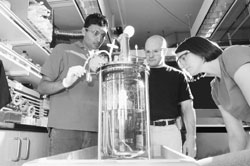Berkeleyan
New science for an age-old ill
Researcher Jay Keasling — working at the intersection of scientific disciplines — engineers microorganisms to help fight malaria
![]()
| 21 January 2004
| |  Jay Keasling (center) watches student researchers use a fermenter to grow cells, such as those genetically engineered to produce an anti-malarial drug precursor. Peg Skorpinski photo |
In the 50 years since Watson and Crick’s work on the double-helix structure of DNA forever changed our view of human biology, science has, of necessity, become a truly interdisciplinary endeavor, rather than one based on rigidly defined fields of study.
One of the advance guard in this revolution is Jay Keasling, a Berkeley professor of chemical engineering. Keasling specializes in metabolic engineering, applying its interdisciplinary insights to problems ranging from environmental pollution (for which he engineers microorganisms capable of breaking down toxic contaminants) to public health.
Keasling has had the latter in his sights recently, through his research on the antimalarial drug artemisinin. Known to the Chinese for 2,000 years as the herbal medicine qinghaosu, artemisinin is effective against malaria strains now resistant to front-line drugs. But the drug is currently too expensive for widespread use in poor nations, particularly in Africa, where malaria kills one child every 30 seconds.
Keasling’s research team combined genes from bacteria, yeast, and the wormwood plant, Artemesia annua, inside the common intestinal E. coli cell. They then engineered them to produce artemisinin more cheaply, efficiently, and safely than possible up to now through traditional fermentation or chemical extraction from the wormwood plant.
These techniques for creating new metabolic pathways inside bacteria could be used to produce chemical precursors to many plant-derived drugs and chemicals, such as antibiotics, the anti-cancer drug Taxol, and food additives.
“We tinker with cells,” says Keasling. “We retool the metabolism in cells to make molecules that would either be made by plants or that aren’t found naturally, or to degrade toxic substances in the environment. . . .We can do in a single enzymatic step what might take 10 steps to do synthetically.”
This metabolic engineering of microbes could eventually replace the expensive and polluting techniques common in the chemical industry today. It requires an interdisciplinary approach to the sciences — in this case an artful blending of chemistry, biology, and engineering — that Berkeley is fostering in a major way, through the Berkeley Health Sciences Initiative as well as the California Institute for Quantitative Biomedical Research (QB3), a partnership between the state of California and UC campuses at Berkeley, San Francisco, and Santa Cruz.
A QB3 participant, Keasling says the interdisciplinary push at Berkeley is part of a broader trend in the sciences. “In biology, for instance, we’re not looking just at a single protein; we’re looking at networks of proteins,” he says. “This takes an understanding of information theory, circuit theory, and systems theory, as well as molecular biology, to understand how the protein networks interact and come together to form a biological circuit.
“Science has progressed so dramatically,” he notes. “It’s the benefit of having the human genome available, and of having sequences available in databases that we can search using the Internet. All of these things have come together.
“When I was a graduate student and an undergraduate, we had very little biology data — we were data-poor,” continues Keasling. “We could write models for our systems to understand how they were working, but we weren’t able to verify the models.
“Now we have more data than we know what to do with,” he says, “and we’re spending time crunching that data to get something useful out of it. It’s an incredibly exciting time to be doing science and engineering.”

